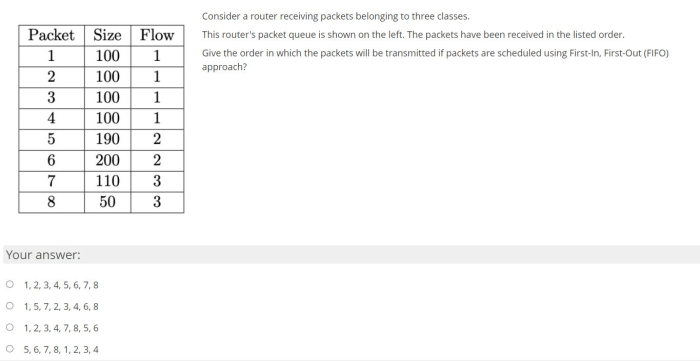A router is receiving a stream of incoming packets – As a router embarks on its critical task of receiving a stream of incoming packets, we delve into the intricacies of this process, exploring the mechanisms that govern packet reception, forwarding, and management. Our journey promises to illuminate the inner workings of a router, shedding light on its vital role in ensuring seamless network communication.
The router’s network interface card (NIC) stands as the gatekeeper, receiving packets from various sources. Once received, these packets are subjected to a meticulous process involving buffer management and error handling, ensuring their integrity before they embark on their onward journey.
Packet Reception Process
When a router receives an incoming packet, it undergoes a series of steps to process it efficiently. The network interface card (NIC) of the router acts as the entry point for packets, receiving them from the network medium.
Upon receiving a packet, the NIC checks for errors using a cyclic redundancy check (CRC). If the packet is corrupted, it is discarded. Otherwise, the packet is buffered in a memory area until the router’s central processing unit (CPU) can process it.
The CPU examines the packet header to determine its destination address. If the destination address matches the router’s own address, the packet is delivered to the appropriate interface for local delivery. Otherwise, the packet is forwarded to the next hop according to the router’s routing table.
Packet Forwarding
![]()
Routers use routing tables to determine the next hop for each packet. Routing tables contain information about the available paths to different network destinations.
When a packet is received, the router compares the destination address with the entries in its routing table. If a match is found, the router forwards the packet to the next hop specified in the table.
Different routing algorithms, such as distance-vector routing and link-state routing, are used to maintain and update routing tables. These algorithms ensure that routers have the most up-to-date information about the network topology and can make optimal forwarding decisions.
Traffic Management

Routers use various techniques to manage incoming traffic and optimize network performance. Traffic shaping controls the rate at which packets are sent into the network, preventing congestion.
Queuing buffers packets that cannot be immediately forwarded due to congestion or other factors. Different queuing algorithms, such as first-in-first-out (FIFO) and weighted fair queuing (WFQ), are used to manage the order in which packets are processed.
Congestion control mechanisms, such as windowing and rate limiting, help prevent network congestion by limiting the amount of traffic that can be sent into the network at any given time.
Security Considerations: A Router Is Receiving A Stream Of Incoming Packets

Routers are vulnerable to various security threats, including unauthorized access, denial-of-service attacks, and malware infections.
Firewalls and intrusion detection systems (IDSs) are commonly used to protect routers from these threats. Firewalls block unauthorized access to the router, while IDSs monitor network traffic for suspicious activity and alert administrators of potential threats.
Best practices for securing routers include keeping software up-to-date, using strong passwords, and disabling unnecessary services.
Performance Monitoring

Monitoring router performance is essential for ensuring optimal network operation. Metrics such as throughput, latency, and packet loss are used to measure router performance.
Performance monitoring tools, such as SNMP (Simple Network Management Protocol) and NetFlow, provide detailed information about router performance and can be used to identify and resolve network issues.
By monitoring router performance, network administrators can proactively address potential problems and ensure that the router is operating efficiently.
FAQ Overview
What is the significance of buffer management in packet reception?
Buffer management ensures that incoming packets are temporarily stored while awaiting processing, preventing packet loss due to network congestion or processing delays.
How do routing tables assist in packet forwarding?
Routing tables contain information about the best paths for packets to reach their destinations. Routers consult these tables to determine the next hop for each packet, ensuring efficient and reliable delivery.
What measures can be taken to secure routers from incoming threats?
Firewalls and intrusion detection systems (IDS) play a crucial role in protecting routers from malicious attacks by filtering out suspicious traffic and detecting potential security breaches.